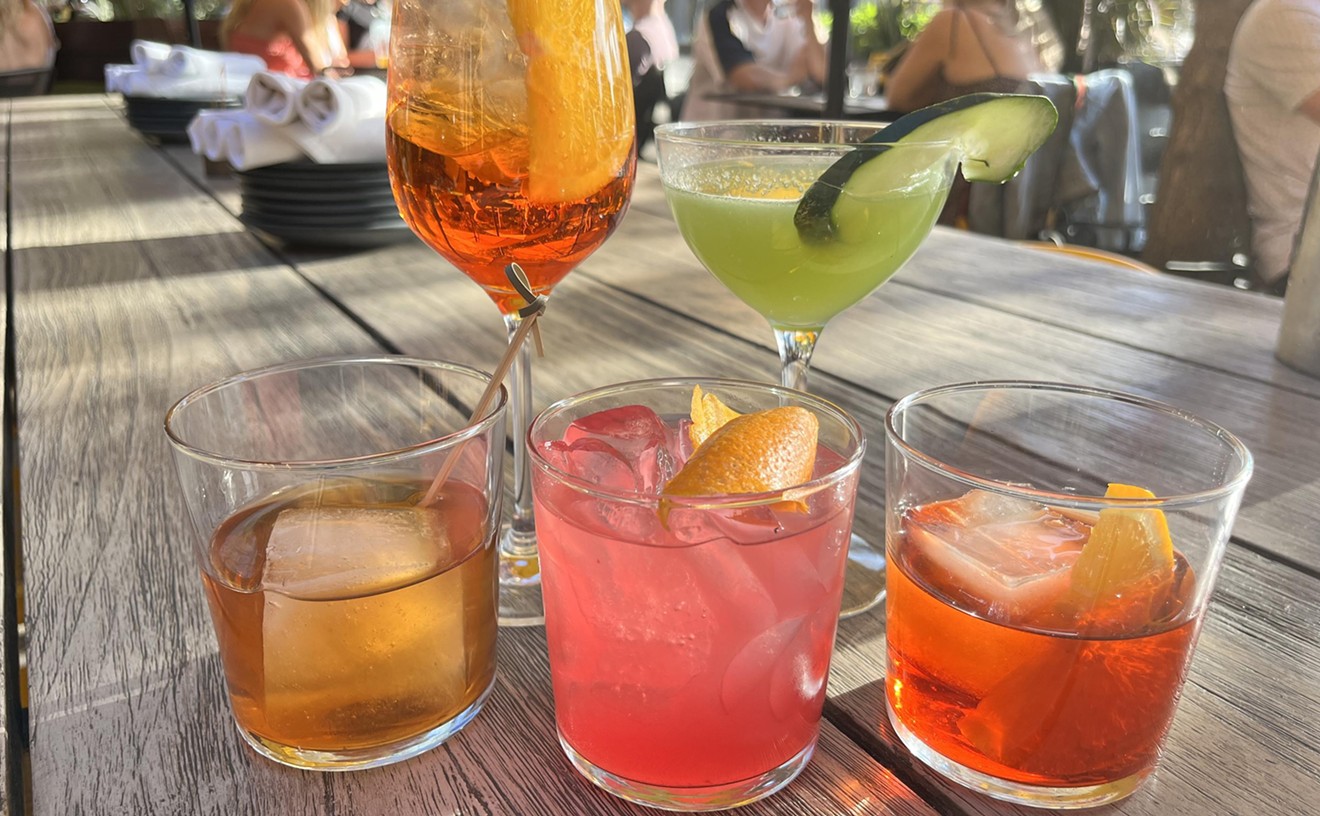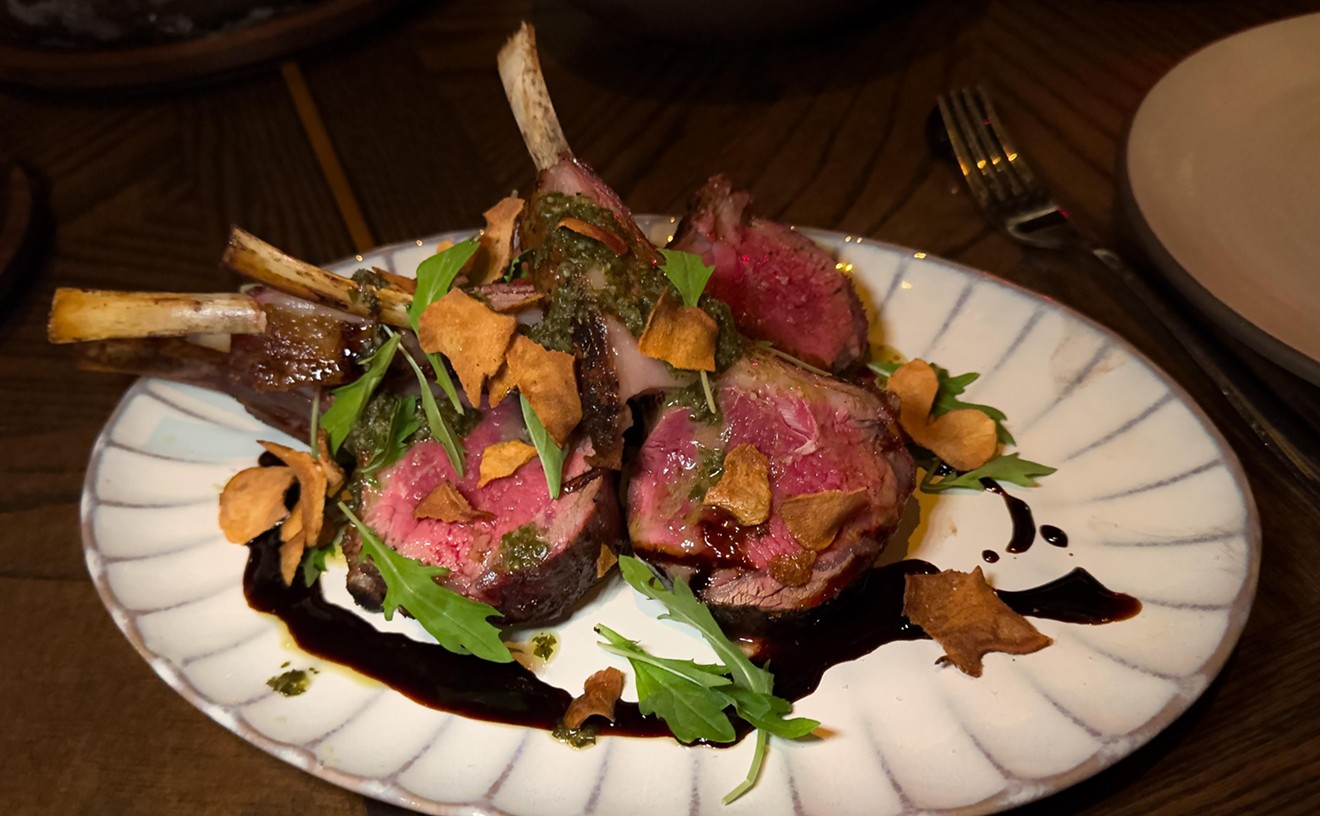Oddly enough, a Mesa mall food court is the only place in the Valley where one can say they've truly eaten the cuisine of a king — or in this case, an emperor.
Here, at a small counter-service eatery, under the glow of fluorescent lights that illuminate shoppers, texting teens, and children shouting excitedly as they ride a miniature merry-go-round, arrives an imperial legacy of dishes served, ironically, atop plastic cafeteria trays onto tables painted with Asian landscapes.
There are ivory platters filled with beautiful banh knot, bite-size versions of the Vietnamese pancake, with a coconut milk-based crunchy exterior and a satisfying filling of shrimp and onions. There also plates of miniature banh loc la, which resemble the insects suspended in amber of Jurassic Park but actually are sautéed shell-on shrimp and crispy, fatty bits of pork floating in translucent pillows of sticky and incredibly chewy tapioca flour wrapped in banana leaves for a sweet taste with a bit of crunch. And there's a tray of dainty dishes containing banh beo, dimpled, petite rice cakes filled with golden shavings of salty dried and ground shrimp, green onions, and one or two bits of crunchy pork skin. Depending on your table manners, these can be scooped out in a single woobly spoonful or slurped like an oyster.
"Sometimes, people have contests to see how many dishes they can stack up," says Lan Ha, owner of Hue Gourmet, her two-year-old eatery in Mekong Plaza, the Asian mall in Mesa. "But that's the nice thing about Hue food. It's served in small portions. If you're still hungry, you can order more."
Distinctive to the rest of the country, the cuisine of the Vietnamese city of Hue (pronounced "hweh") has a royal pedigree because of its status as the imperial capital of the Nguyen dynasty between 1802 and 1945. Because emperors would eat dozens of dishes at a single meal, they were created to be smaller, presented as aesthetically pleasing gastronomic works of art, and featured a mix of flavors and textures that could be savored in a single bite.
Hue Gourmet offers diners a taste of the city's royal side as well as more modern-day meals inspired from throughout Vietnam. Uncommon, highly flavorful, and ridiculously affordable, it's a rare treat for lovers of Vietnamese food and a one-of-a-kind experience for everyone else.
There are no appetizers, entree, or dessert sections at Hue's counter stand — you simply look at the pictures plastered to the back wall or the specials up front and point at whatever strikes your fancy. A bit daunting for the uninitiated, to be sure, which is why it's best for newcomers to seek the assistance of a friendly counter person — perhaps even Ha herself. Better still if you bring a few friends along. Trying a selection of bite-size treats, snacks, rice dishes, and soups (most under $7) together makes for a lively and flavor-filled afternoon.
If it's on the specials board, you could start with a banh gio trung cut, a pyramid-shaped snack whose ivory rice dough dumpling filled with fried and seasoned minced pork, wood ear mushrooms, and a hard-boiled quail egg wrapped in a banana leaf is the equivalent of an exotic, snack-size breakfast already wrapped to go. There also is cha the, a thin slice of steamed pork that Ha seasons with garlic, onions, and black pepper for something that's more or less the equivalent of sausage. The banana leaf wrapping gives it Asian flair. More familiar to the Western palate is cha gio tom, thin yet densely packed crispy shrimp egg rolls made with shredded taro root to soak up the moisture. It's best when eaten wrapped in lettuce, sprinkled with fresh mint leaves, and dipped in a small dish of delicate nuoc cham.
If you are a fan of banh mi, you've probably had something similar to Hue Gourmet's banh mi thit nguoi. Like most of the dishes here, this classic version of the Vietnamese sandwich is served small-scale. Filled with cold slices of springy, moist housemade head cheese, daikon and carrot pickles, cucumbers, jalapeños, and cilantro packed into light and crunchy French bread, it's a lively array of flavors. One would make a tasty snack or accompaniment to a soup. Two and you've got yourself a light lunch.
And there are soups, of course. Big bowls of hot, steaming broths you can smell before they are set on the table. They're accompanied by must-adds such as fish sauce, fresh vegetables, limes, perilla (an herb of the mint family), and sometimes a brown nest of thin, shredded banana blossom, which has the texture of cabbage but tastes a bit like artichoke. Ha tells me it's one of the few plants that can make it through a rainy season in Hue.
Ha's version of bun bo Hue, which originated in the imperial capital, is not to be missed.
Like traditional pho bo, this classic beef noodle soup is simmered with handfuls of Asian spices and beef bones, but that's where the similarities stop. Finishing the broth with lemongrass and red chiles is what gives bun bo Hue its distinctive flavor, and Ha's version — made with slices of pork and huyet (congealed pig blood) and served with a side of shrimp paste as a condiment — is rich and bold with a steady, mild heat throughout.
"Sometimes I think the pig blood scares my American customers," Ha says, "and I leave it out."
As good as the bun bo Hue is the crab soup, banh canh cua. Packed with lumps of crab meat, pudgy pink shrimp, hard-boiled quail eggs, and slightly chewy Vietnamese noodles in an opaque, rust-colored broth with hints of pork and handfuls of garlic and onion, it is deeply flavorful and by far one of the most hardy and comforting dishes on the menu.
If you're going to take the time to indulge in the cuisine of the ancient citadel of Vietnam, the least you can do is try its specialty, com hen song huong (or com hen for short). It doesn't sound very appetizing — baby clam meat over rice with vegetables and clam juice — but this popular street food of Hue actually is a unique and intricate dish that gets better with every bite. Sometimes requiring up to 15 different raw materials to prepare it, Ha's version includes ingredients like rice, peanuts, taro stems, pork belly, minced banana flowers, jagged pieces of Vietnamese sesame rice crackers, and slices of green apple that she uses in place of starfruit.
You are responsible for pouring the clam broth, served in a separate bowl, over this textural potpourri of ingredients; it will be just enough to moisten them. The result is a complex medley of sweet, salty, sour, bitter, and peppery-hot flavors — and a taste as addictively peculiar as it is intense.
As if Hue Gourmet's one-of-a-kind food served up in a cafeteria isn't remarkable enough, the story of its owner, Lan Ha, is equally extraordinary.
In 1986, Ha's mother paid three ounces of gold to secure a spot for her 19-year-old daughter on a boat with others fleeing the Communist government in the era of Vietnamese "boat people."
"I wanted an education and a future," Ha says of her refugee flight. "I was alone, there was little to eat, and I was afraid of pirates."
Making her way to the United States, specifically to Tempe, in 1989, Ha fulfilled her dream of attending college, and she secured a job as an engineer. Unable to find the food of her hometown in the Valley, Ha began making the dishes she remembered from scratch, eventually selling some of them through the Internet. In 2010, she quit her corporate gig and opened Hue Gourmet.
"I never knew I was going to be a cook," she confesses, "but I knew I loved cooking."
Chances are you'll love her cooking, too.










